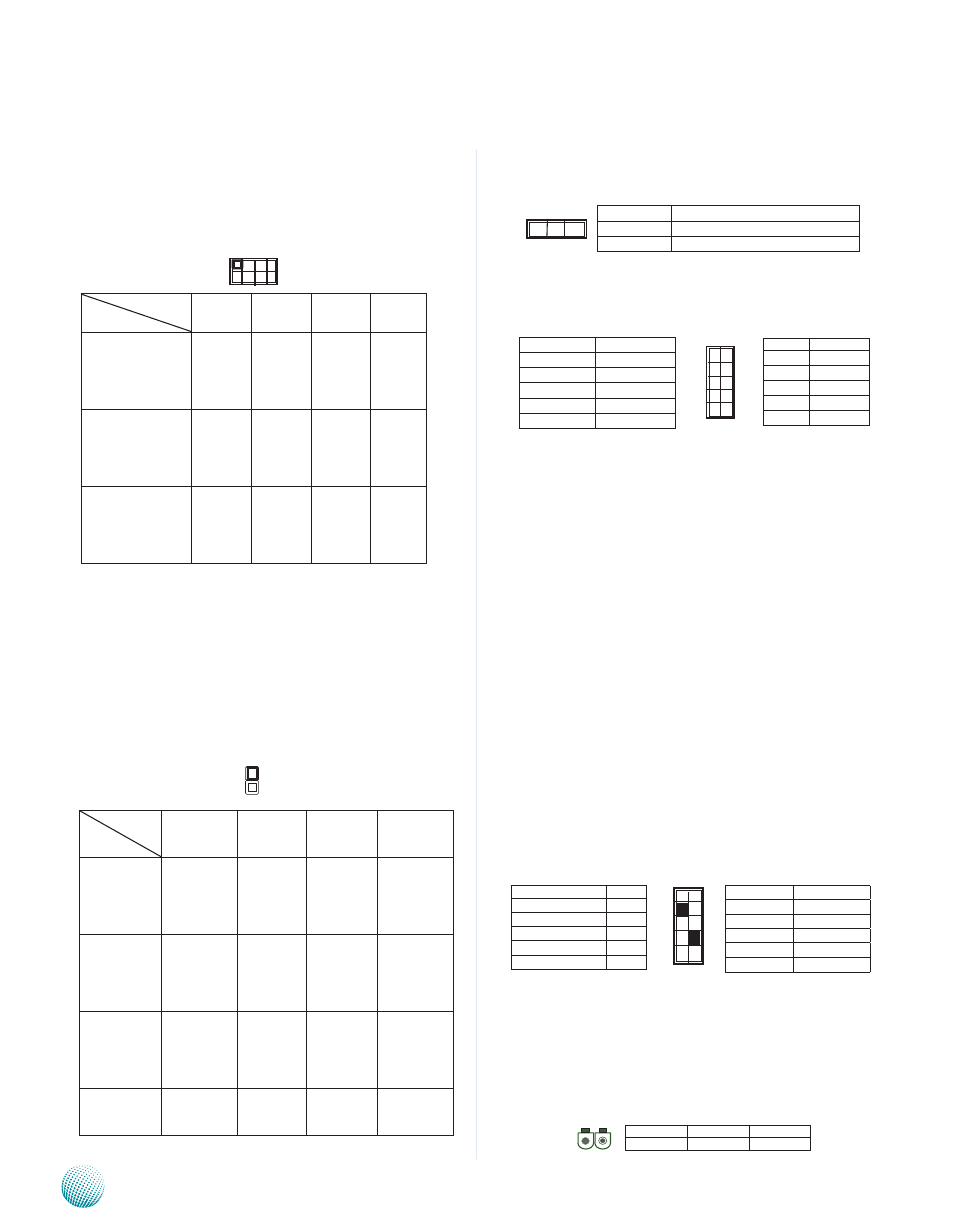Chapter 3, Motherboard information – Lanner LEC-3000A User Manual
Page 13

11
Motherboard Information
Chapter 3
Embedded and Industrial Computing
SW2/SW3/SW4/SW5: These switches — SW2, SW3, SW4
and SW5 — are used to adjust the serial port type for
COM1, COM2, COM3, and COM4 respectively Use the
table below as the switch adjustment information for
COM1 through COM4
COM Port No.
Port Type
COM 1
COM 2
COM 3
COM 4
RS-232
Switch 2:
1 ON
2 OFF
3 OFF
4 OFF
Switch 3:
1 ON
2 OFF
3 OFF
4 OFF
Switch 4:
1 ON
2 OFF
3 OFF
4 OFF
Switch 5:
1 ON
2 OFF
3 OFF
4 OFF
RS-422
Switch 2:
1 OFF
2 ON
3 ON
4 OFF
Switch 3:
1 OFF
2 ON
3 ON
4 OFF
Switch 4:
1 OFF
2 ON
3 ON
4 OFF
Switch 5:
1 OFF
2 ON
3 ON
4 OFF
RS-485
Switch 2:
1 OFF
2 ON
3 OFF
4 ON
Switch 3:
1 OFF
2 ON
3 OFF
4 ON
Switch 4:
1 OFF
2 ON
3 OFF
4 ON
Switch 5:
1 OFF
2 ON
3 OFF
4 ON
SW6/SW7/SW8/SW9: These switches — SW6, SW7,
SW8 and SW9 — are used to enable or disable the
signal termination for COM1, COM2, COM3, and
COM4 respectively Use the table below for the switch
adjustment information for COM1 through COM4 We
strongly recommend that you disable termination when
the port is configured as RS-232 and enable it when the
port is configured as RS-485/RS-422
CMOS1: This jumper provides a means to return the BIOS
settings to its default state automatically on power-up
SPI-ROM(J1): Using the appropriate cable to connect this
10-pin ISP in header connector, the user can update the
SPI Flash soldered on board
CN1: Connector CN1 provides access to the COM1
through COM4 serial port’s data transmission when the
port is configured for either RS-422/RS-485 or RS-232 serial
protocol The signals present on each of the connector’s
pins for these three modes can be referenced in Front
Panel Features, Chapter 1 Introduction The COM ports'
serial protocol mode is configured using the following
dip switches: SW2, SW3, SW4, and SW5 In addition, when
used as in RS-485 mode, the system can automatically
detect the direction of incoming data and switches its
transmission direction accordingly - the automatic data
flow control in RS-485 Hence, no handshaking signal (RTS
signal) is necessary This allows you to conveniently build
an RS-485 network with just two wires More significantly,
application software previously written for half duplex
RS-232 environments can be maintained without
modification
USBF1: Dual USB Interface Connector (USB No 4 and
No 5): It is used for connecting the USB module cable
It complies with USB2 0 and support up to 480 Mbps
connection speed
CF1: A Compact Flash Connector It is used for connecting
a Compact Flash card to serve as your system's storage
CN1(on DC/DC converter board): A power socket for a
power supply through Phoenix Contact
ON
1 2 3 4
3 2 1
Pin No.
Function
Short 1-2
Normal (Default)
2-3
Clear CMOS
Pin No.
Function
2
RSVD
4
+3.3V
6
RSVD
8
SPI_CLK
10
SPI_MOSI
Function
Pin No.
SPI_HOLD_N
1
SPI_CS0_N
3
SPI_MISO
5
RSVD
7
GND
9
1
3
5
7
9
2
4
6
8
10
Pin Name
Pin No.
USB_VCC4
1
3
USBD4N
5
USBD4P
7
GND
9
Pin No.
Pin Name
2
GND
4
USBD5P
6
USBD5N
8
10
USB_VCC5
1
3
5
7
9
2
4
6
8
10
Pin No.
1
2
Function
Ground
DC=In
12
ON
OFF
COM
Port No.
Port Type
COM 1
COM 2
COM 3
COM 4
RS-232
Switch 2:
1 ON
2 OFF
3 OFF
4 OFF
Switch 3:
1 ON
2 OFF
3 OFF
4 OFF
Switch 4:
1 ON
2 OFF
3 OFF
4 OFF
Switch 5:
1 ON
2 OFF
3 OFF
4 OFF
RS-422
Switch 2:
1 OFF
2 ON
3 ON
4 OFF
Switch 3:
1 OFF
2 ON
3 ON
4 OFF
Switch 4:
1 OFF
2 ON
3 ON
4 OFF
Switch 5:
1 OFF
2 ON
3 ON
4 OFF
RS-485
Switch 2:
1 OFF
2 ON
3 OFF
4 ON
Switch 3:
1 OFF
2 ON
3 OFF
4 ON
Switch 4:
1 OFF
2 ON
3 OFF
4 ON
Switch 5:
1 OFF
2 ON
3 OFF
4 ON
Termination
(Enable/dis-
able)
Switch 6:
Enable ON
Disable: OFF
Switch 7:
Enable ON
Disable: OFF
Switch 8:
Enable ON
Disable: OFF
Switch 9:
Enable ON
Disable: OFF
OFF
